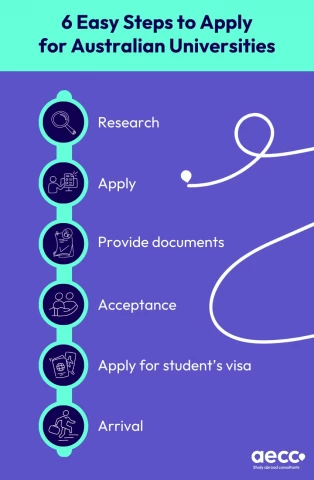Nepalese students across the globe are increasingly opting to study in the Land Down Under. And rightly so—with an enthralling culture, unbeatable beaches, plus educational standards that are among the best in the world, who wouldn't?
These wonderful features of Australia have sparked a great deal of interest among Nepalese students in Australia, particularly in regards to admissions to Australian universities. To cater to this curiosity of the Australian educational system we will cover everything about the Australian intake months, timelines, universities and much more.
Table of Contents
- Main Intakes in Australia for International Students
- Australian University Intakes
- Deadlines for Admission in top Australian Universities
- Which Intake in Australia should I go for?
- Eligibility Criteria for Intakes in Australia
- Documents required for Admission Intakes in Australia
- How to apply for Australian intakes in 6 simple steps?
- Unique facts about Intake seasons at Australian Universities
- Myths about different Intakes in Australia
Main Intakes in Australia for International Students:
- February intake
- July intake
- September intake
There are two primary international student intakes in Australia:
Semester 1: This intake runs from the end of February or the beginning of March until the end of May or the beginning of June. For the majority of universities and courses, this is the main intake.
Semester 2: This intake runs from the end of July or the beginning of August through the end of October or the beginning of November. Certain universities and courses may also offer a mid-year intake in July for some curricula.
Also, some Australian universities accept applications throughout the year. However, such choices are limited. In addition to the above two intakes in Australia, there is another intake, the September intake, also known as Semester 3, with even fewer courses.
| Intakes in Australia | Starts from |
| February/Semester 1/T1 | Late February or early March to late or early June |
| July/Semester 2/T2 | Late July/early August through November |
| September/Semester 3/T3 | Late October/early November through February |
Australian University Intakes:
You now know the standard intake timeline for Australian universities. The catch is these timeframes may not match the admissions deadlines for all universities. But, don't worry! We've got the insights just for you.
The table below lists some of the top Australian university intake times:
| Intakes | University |
|
February
|
Australian National University (ANU) |
| University of Sydney | |
| University of Melbourne | |
| University of New South Wales (UNSW) | |
| University of Queensland | |
| Monash University | |
| University of Western Australia | |
| University of Adelaide | |
| University of Technology, Sydney | |
| University of Wollongong | |
|
July
|
Australian National University |
| The University of Sydney | |
| The University of Melbourne | |
| University of New South Wales | |
| Monash University | |
| The University of Western Australia | |
| The University of Adelaide | |
| `University of Technology, Sydney | |
| Macquarie University | |
| Curtin University | |
| Queensland University of Technology | |
| RMIT University | |
|
September
|
Bond University |
| Australian National University | |
| University of New South Wales (UNSW) | |
| Charles Sturt University | |
| CQ University | |
| University of Southern Queensland |
Deadlines for Admission in top Australian Universities:
If you're thinking about applying to one of Australia's best universities in 2023 or 2024, you should be aware of the important dates, which can change from institution to school. But to give you a rough sense about the timeline, here is our list:
| Name of university | Last dates for application |
| Monash University | Application deadline starts from May 1st-31st, 2023 for September intake |
| Deakin University | Application open for February intake 2023 |
| James Cook University | Application due by 2 July 2023 for September intake |
| The University of Sydney | Semester 1: February 19, 2024* Semester 2: July 29, 2024 |
| RMIT University | Application open from March 2 for September intake |
| Canberra University | 14 July 2023 application ends for August Semester |

Your unique circumstances and preferences will ultimately determine which intake you should apply for in Australia.
In Australia, universities typically have two intakes, which are:
First semester: The application date is often in November or December of the year prior, and the first semester typically starts in February or March.
Second semester: The application date is often in May or June, and the second semester typically starts in July or August.
Factors to consider when choosing which Intake to apply for:
Programme availability: It is crucial to verify with the institution to determine which intake your preferred programme is offered in since some programmes may only be available in one of the intakes.
Time required for visa processing: If you are an international student, you should take this into account while choosing your intake. It is advised that you submit your visa application at least three months before your program's start date.
Personal circumstances: Take into account your own circumstances, including your preferred start date for your programme and any obligations that might influence your choice.
Scholarship availability: It is necessary to check with the university and scholarship providers as some scholarships may only be offered for specific intakes.
Eligibility Criteria for Intakes in Australia:
When applying to an Australian university, certain requirements must be met in order to qualify, be it for educational or employment purposes. Let's understand them, shall we?
- For undergraduate courses, a high school diploma or equivalent qualification is required.
- For postgraduate courses, a bachelor's degree or equivalent qualification is required.
- English language proficiency test scores such as IELTS or TOEFL may be required.
It is interesting to keep in mind that different universities may have different eligibility requirements as per the demands of the course. Students should keep checking the eligibility criteria for their chosen course.
Documents required for Admission Intakes in Australia:
After you are admitted to the July intake in Australia, you must submit the below-mentioned documents.
- All certified transcripts and prior academic records from accredited institutions of higher learning
- For the July intake in Australia, IELTS requires a minimum score of 6–6.5 and higher for undergraduate programmes and 7–7.5 and above for graduate programmes
- Further test results, if requested or necessary by the university
- SOP (Statement of Purpose)
- At least two letters of recommendation (LORs)
- Updated CV or Resume
- Passport-size photographs
- Visa
How to apply for Australian intakes in 6 simple steps?
- Research: Research different universities and courses in Australia that interest you and find out their specific entry requirements, application deadlines, and English language proficiency requirements.
- Apply: Once you have identified the university and course you want to study, you will need to apply directly to the university. You can usually do this online via the university's website, and you may need to pay an application fee.
- Provide documents: You will need to provide supporting documents such as your academic transcripts, English language proficiency test results, and passport details.
- Acceptance: If your application is successful, you will receive a letter of offer from the university. You will then need to accept the offer and pay a deposit to secure your place.
- Apply for a student visa: Once you have accepted the offer, you will need to apply for a student visa. You can do this online through the Department of Home Affairs website. You will need to provide evidence of your enrollment in a course, proof of financial support, and meet health and character requirements.
- Arrival and enrollment: Once you have received your student visa, you can make arrangements to travel to Australia and enrol in your chosen course.
- Two intakes per year: Most Australian universities have two main intakes per year, with the first intake usually in February or March and the second intake in July or August. However, some universities may also have additional intakes in November or December.
- Rolling admissions: Unlike some other countries, Australian universities generally have rolling admissions. This means that universities may continue to accept applications even after the official deadline has passed, as long as there are places available in the course.
- Flexible course start dates: Some Australian universities offer flexible course start dates, allowing students to start their course at different times throughout the year. This can be particularly useful for international students who may have visa or travel restrictions.
- Different application deadlines: Application deadlines for different courses and programmes can vary, so it's important to check the specific deadline for the course you are interested in. Some universities may have earlier deadlines for certain programmes, such as medicine or law.
- Summer and winter schools: Some Australian universities also offer summer and winter schools, which are short-term programmes that run during the summer or winter break. These programmes can be a great way to gain extra credit or experience, and they may have different application deadlines and requirements than regular courses.
Myths about different Intakes in Australia:
| Myths | Facts |
| The February/March intake is better than the July/August intake. | Both intakes offer the same quality of education and opportunities, and it's up to the individual student to decide which intake suits them better. Some courses may only be offered in one intake, so it's important to check the availability of the course before making a decision. |
| It's harder to get accepted in the second intake. | Acceptance into courses is based on academic performance and meeting the entry requirements, and not on the intake season. However, some courses may have limited places available, and these places may fill up quickly in either intake. |
| It's too late to apply for the first intake if you miss the deadline. | Australian universities often have rolling admissions, meaning they may accept applications after the deadline as long as there are places available in the course. It's best to check with the university directly to see if they are still accepting applications for the intake. |
| The second intake is only for international students. | Both intakes are open to both domestic and international students. However, international students should be aware that visa processing times may take longer for the second intake, which may affect their ability to travel to Australia in time for the start of the course. |
| You can't switch between intakes once you have started your course. | Some universities may allow students to switch intakes or defer their start date, but this will depend on the specific policies of the university and the course. It's important to check with the university before making any decisions. |





